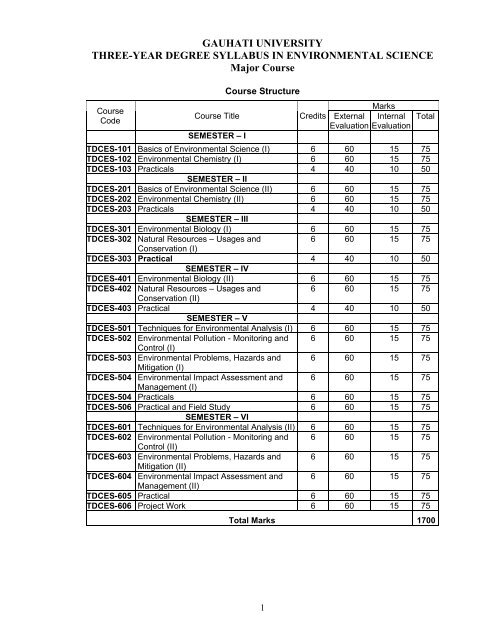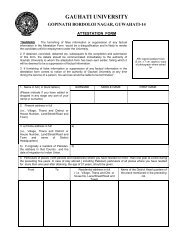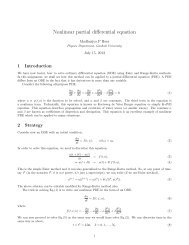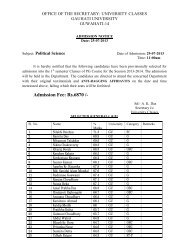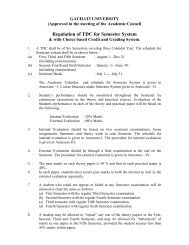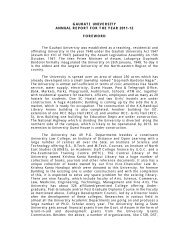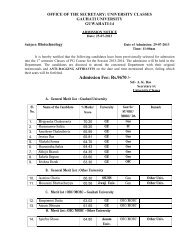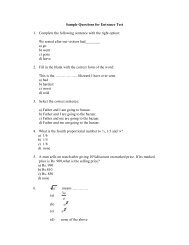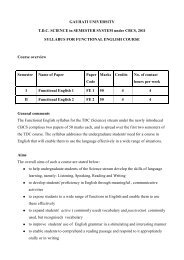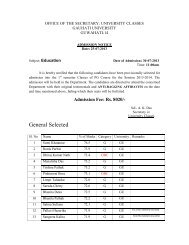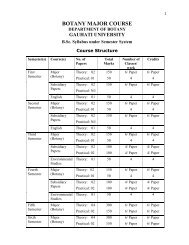ENVIRONMENTAL SCIENCE (Major) Syllabus - Gauhati University
ENVIRONMENTAL SCIENCE (Major) Syllabus - Gauhati University
ENVIRONMENTAL SCIENCE (Major) Syllabus - Gauhati University
Create successful ePaper yourself
Turn your PDF publications into a flip-book with our unique Google optimized e-Paper software.
GAUHATI UNIVERSITYTHREE-YEAR DEGREE SYLLABUS IN <strong>ENVIRONMENTAL</strong> <strong>SCIENCE</strong><strong>Major</strong> CourseCourseCodeCourse TitleSEMESTER – ICourse StructureCreditsMarksExternal InternalEvaluation EvaluationTotalTDCES-101 Basics of Environmental Science (I) 6 60 15 75TDCES-102 Environmental Chemistry (I) 6 60 15 75TDCES-103 Practicals 4 40 10 50SEMESTER – IITDCES-201 Basics of Environmental Science (II) 6 60 15 75TDCES-202 Environmental Chemistry (II) 6 60 15 75TDCES-203 Practicals 4 40 10 50SEMESTER – IIITDCES-301 Environmental Biology (I) 6 60 15 75TDCES-302 Natural Resources – Usages and6 60 15 75Conservation (I)TDCES-303 Practical 4 40 10 50SEMESTER – IVTDCES-401 Environmental Biology (II) 6 60 15 75TDCES-402 Natural Resources – Usages and6 60 15 75Conservation (II)TDCES-403 Practical 4 40 10 50SEMESTER – VTDCES-501 Techniques for Environmental Analysis (I) 6 60 15 75TDCES-502 Environmental Pollution - Monitoring and 6 60 15 75Control (I)TDCES-503 Environmental Problems, Hazards and 6 60 15 75Mitigation (I)TDCES-504 Environmental Impact Assessment and 6 60 15 75Management (I)TDCES-504 Practicals 6 60 15 75TDCES-506 Practical and Field Study 6 60 15 75SEMESTER – VITDCES-601 Techniques for Environmental Analysis (II) 6 60 15 75TDCES-602 Environmental Pollution - Monitoring and 6 60 15 75Control (II)TDCES-603 Environmental Problems, Hazards and 6 60 15 75Mitigation (II)TDCES-604 Environmental Impact Assessment and 6 60 15 75Management (II)TDCES-605 Practical 6 60 15 75TDCES-606 Project Work 6 60 15 75Total Marks 17001
SEMESTER – ITDCES-101:Basics of Environmental Science (I) – 6 CreditsUnit 1: Environment: Definition, Environmental Factors, Global Environment andits segments – atmosphere, hydrosphere, lithosphere and biosphereEnvironmental Science – meaning, scope and importanceUnit 2: Atmosphere: Origin and composition, Thermal structure and atmosphericstratification, Water vapour and Green house gases in atmosphere, Solarradiation and terrestrial heat balance, Atmosphere as a heat engineAtmospheric variables and their vertical profile, Hydrostatic balance of theatmosphere, Temperature lapse rate, Temperature inversion and atmosphericstabilityUnit 3: Weather and Climate: Weather elements – atmospheric pressure,temperature, relative humidity, sunshine and cloudiness, winds andprecipitation; Different types of winds, Air masses, Cyclones and Anticyclones;Earth’s thermal environment and seasons, <strong>Major</strong> Climatic Zones of the world,Climates of India, Indian Monsoon, Tropical Cyclones and WesternDisturbances, Climatic variability and climate changeUnit 4 : Hydrosphere : Importance and characteristics, Zones of hydrosphere,Different kinds of sources of water – Ice-cap, glaciers, oceans, rivers, lakes,pond and ground water; Inventory of World’s water, Hydrologic cycle, Water asa resource, Water resources of Northeast IndiaUnit 5: Lithosphere: Earth’s layers, Earth’s crust and its composition, Differentkinds of rocks and minerals, <strong>Major</strong> landforms, Soil – composition andclassification, Soil horizon; <strong>Major</strong> physiographic divisions of IndiaTDCES-102:Environmental Chemistry (I) – 6 CreditsUnit 1: Basic Concepts: Concept and scope of Environmental Chemistry,Stoichiometric calculations, acid base reactions, pH and pOH, ionic product ofwater, common ion effect, buffer solution, solubility and solubility product,solubility of gases in water; chemical equilibrium, conductance, oxidation andreductionUnit 2: Classification of elements: s-p-d-f block elements and theircharacteristics, Chemical speciation, chemistry of corrosion (electro-chemicaltheory of corrosion), metabolic, neurotoxic and carcinogenic compoundsUnit 3: Chemistry of air: Particles, ions and radicals in the atmosphere, chemicaland photochemical reactions, oxygen and ozone chemistry, greenhouse gasesand their effectsUnit 4: Chemistry of Water: Physical and chemical properties of terrestrial andmarine water, complexation in natural and wastewater. Concept of DO, BOD,COD and threshold number, role of water in environment, water qualityparametersUnit 5: Chemistry of Lithosphere: Chemical composition of rocks, minerals andsoil; Relation between crustal abundance of elements and mineral resources;Thermodynamical aspects of ore mineral formationTDCES-103:Practicals – 4 Credits1. Handling of Meteorological instruments.2. Collection, analysis and interpretation of weather data3. Preparation of climatic maps and diagrams (Hytherograph and Climograph)4. Water balance analysis of a place by Thornthwaite Method5. Identification of Rocks and Minerals6. Analysis of Particle size of soil by hydrometer method.75 marks10 marks20 marks20 marks15 marks10 marks75 marks15 marks15 marks15 marks15 marks15 marks50 marks2
SEMESTER – IITDCES-201:Basics of Environmental Science (II) – 6 CreditsUnit 1: Biosphere: Definition and extent, Biomes – Tundra, Taiga, Temperate andDeciduous forest, Grassland, Desert, Tropical rain forest and marineA short introduction to biogeography, General relationship betweenlandscape, biomes and climateUnit 2: Earth Processes: Weathering and soil formation, Mass wasting, fluvialgeomorphic cycleUnit 3: Fundamentals of Ecology: Definition, Subdivisions; Concept of Ecosystem- producers, consumers, decomposers, nutrient pool; Biotic and abiotic factors,Different kinds of ecosystems, Habitats and NicheUnit 4: Man and Environment: Biological growth curves and carrying capacity,Human population growth and migration, Factors responsible for rural andurban population growth, Human impact on ecosystems.Population growth and distribution in India with special reference toNortheast IndiaEffects of environment on human culture, food habit, livelihood andhealth.Unit 5: Environmental Education: Environmental ethics, Environmentalawareness - role of youth, communities, NGOs and professional.Environmental education at primary and secondary levels, Environmentaleducation for masses - rural and urbanTDCES-202: Environmental Chemistry (II) – 6 CreditsUnit 1: Biogeochemical Cycles: Oxygen, Carbon, Nitrogen and PhosphoruscyclesUnit 2: Chemical kinetics: First, second and zero order reaction, Catalysis andcatalytic reactions, Adsorption and adsorption isothermsUnit 3: Chemistry of cleaning agents - Soap, detergents and bleaching agents,Chemical process- photosynthesis, fermentation and biodegradationUnit 4: Complex Compounds: Complex compounds formation with toxic metal likeFe, Pb, Cu, Cd, and Hg; Organic compounds - Hydrocarbons, PAH, PCBs,Halo compounds (elementary concept), CFCs, Phenols, Pesticides andSynthetic fertilizers and their environmental effects375 marks15 marks15 marks20 marks15 marks10 marks75 marks15 marks15 marks15 marks15 marksUnit 5: Analytical methods: Chromatography – TLC, GLC,, HPLC, Atomic 15 marksAbsorption Spectrometry, UV and visible spectroscopy, Solvent extractionTDCES-203:Practicals – 4 Credits50 marks1. Determination of Water holding capacity and Alkalinity of soil by titration method.2. Analysis of soil pH, moisture, soil type and conductivity3. Determination of pH, Conductivity, TDS and Turbidity of water4. Determination of Alkalinity and Hardness of wastewater5. Determination of Chlorides in water sample6. Determination of Sulphates in water sampleSEMESTER – IIITDCES-301:Environmental Biology (I) – 6 CreditsUnit 1: Introduction: Definition, principles and scope; Adaptation, evolution andclassification of organisms, Community - definition, diversity, stratification,fluctuation within community, interdependence; Ecotone and edge effect;Ecological Niche, Ecotype, Ecological indicators and Ecological succession75 marks15 marksUnit 2: Ecosystem: Definition, structure, type, dynamics, primary and secondary 15 marks
productivity, C3 and C4 pathways and significance; Trophic level andpopulation stability; Food chain, food web, Ecological pyramids, Energy andnutrient flow through ecosystemDifferent kinds of ecosystems - forest, grassland, wetland, pond and riverecosystemsUnit 3: Taxonomy: Taxonomic Principles; Classification of plants and animals upto generic groups; Two major systems of classification (plants and animals) forfield identificationUnit 4: Population dynamics: Definition, population density, Natality, Mortality,Age structure, Growth pattern, Fluctuation and equilibrium, Biotic potentials,population dispersion. Factors affecting human population size, Densitydependentand density-independent factors of population regulationUnit 5: Biodiversity and its conservation: Definition, Hotspots of Biodiversity,Strategies for Biodiversity conservation, National Parks and Sanctuaries, Genepool conservationTDCES-302:Natural Resources – Usages and Conservation (I) – 6 CreditsUnit 1: Introduction: Concept of natural resources, resources and reserves,Various types of natural resources, Renewable and non-renewable resources,depletion and conservation of natural resources.Mineral, forest and water resources of India with special reference toNortheast India - their exploitation and depletionUnit 2: Water Resources: The hydrologic cycle and its components, Inventory ofEarth’s water, properties of water, Surface Water - Rainwater, ponds lakes,springs, rivers, etc.; Groundwater, Degradation of water resources, theirprotection and conservation, Concept of watershed management; surface andgroundwater resources monitoring.Unit 3: Wetlands: Concept of wetlands, The Ramsar convention, Wetlands forhuman use and environmental importance, Wetland management and Nationalwetland policyUnit 4: Land resources: Different categories of land and their uses, Landdegradation and Soil erosion; Wasteland and their reclamationUnit 5: Forest resources: Different types of forests, Forests products and theirexploitation, Forest protection and management, Forest products of NortheastIndia415 marks15 marks15 marks75 marks15 marks15 marks15 marks15 marks15 marksTDCES-303:Practical – 4 Credits50 marks1. Identification of local Flora and Fauna2. Determination of minimum size and number of quadrate3. Estimation of frequency, density and abundance of Species in a grassland ecosystemby quadrate method4. Determination of association between two species in community by 2X2 contingencytable and Χ 2 – test method5. Determination of Diversity Index & Biotic Indices6. Estimation of canopy cover and basal cover by different species in grassland ecosystemby point frame method.SEMESTER – IVTDCES-401:Environmental Biology (II) – 6 CreditsUnit 1: Common flora and fauna of Northeast India: Terrestrial – forest’s floraand fauna; Aquatic – Phytoplankton, Zooplankton and MacrophytesUnit 2: Rare, endangered and threatened species in North East India.Unit 3: Environmental Biotechnology: Vermiculture technology, Bio-fertilizertechnology, Biological nitrogen fixation and Bioremediation75 marks15 marks15 marks15 marks
Unit 4: Wildlife management and conservation: History, meaning and scope,Strategies for management of National Parks and Sanctuaries; Factorsinfluencing wildlife management such as - habitats, behavior, food-habits,health and diseases, population pressure.; Role of fringe village communities inwildlife management.Unit 5: Case Studies: Manas bioreserve – Flora and fauna - their conservationand management; Kaziranga National Park – Flora and fauna - theirconservation and managementTDCES-402: Natural Resources – Usages and Conservation (II) – 6 CreditsUnit 1: Mineral resources: Important mineral resources and their reserves in India;mineral deposits in Northeast IndiaUnit 2: Human resources: Concept of human resource; Human population as aNational Resource, Contemporary human ecology; Values and ethics of humanand environment as resources for contemporary developmentUnit 3: Energy resources: Various kinds of energy sources, their availability, usesand classification; Renewable and non-renewable sources of energy; Solarenergy and conventional fuels, Non-conventional sources of energy, Biomassand biogasUnit 4: Environmental problems due to Resource Exploitation: Mining andEnvironment, Open cast mining, Oil exploration and transportation,Deforestation and their impact on environment.15 marks15 marks75 marks15 marks15 marks15 marks15 marksUnit 5: Power generation and Environment: Methods of power generation and 15 markstheir impact on environment – Hydroelectric, Thermal and NuclearTDCES-403:Practical – 4 Credits50 marks1. Determination of leaf area index by Planimeter Method2. Determination of Nitrogen in plant leaf3. Determination of Sulphur in plant leaf4. Plankton identification and quantification from river/ lake water samples5. Preparation of media for microbial culture, Isolation and culturing of microbes from soil/water samples6. Measurement of parameters of an artificial pond or lake to find out its – (i) mean depthand (ii) index of lake performanceSEMESTER – VTDCES-501:Techniques for Environmental Analysis (I) – 6 Credits75 marksUnit 1: Introduction: Environmental Variables, Discrete and continuous variables, 15 marksMethods of collection of Environmental Data; Different kinds of data –primary and secondary data, spatial and non-spatial data; and methods fortheir analysis and interpretation; Methods of collection of data – theiradvantages and limitationsUnit 2: Basic Statistics: Frequency distribution, Tabulation and presentation ofdata; Measures of central tendency; Measures of Dispersion, Skewness andKurtosisUnit 3: Introduction to Sample Survey: Concept of population, sample,parameter and statistic; Different techniques of sampling – judgmentsampling, simple random sampling, stratified random sampling, systematicsampling, multistage sampling; Relative advantages and disadvantages ofdifferent techniquesUnit 4: Correlation and Regression: Simple (linear) Correlation and Regression,and their applications; Multiple Correlations; Introduction to time seriesanalysis15 marks15 marks15 marks5
Unit 5: Theoretical Distributions: Concept of probability, Random variable anddistribution functions, Standard Probability distributions – Binomial andNormal distributionsTDCES-502:Environmental Pollution - Monitoring and Control (I) – 6 CreditsUnit 1: Introduction to Environmental Pollution: Definition, causes and types –air, water, soil, noise, radiation and thermalUnit 2: Air Pollution: Causes of air pollution, Some important pollutants of air(CO X , SO X , NO X and HC and Particulates) – their sources and effects onliving and non-living organisms; Photochemical Smog - Definition, formation,types and effects; vehicular pollution; Case study – Bhupal gas tragedy.Unit 3: Monitoring and Control of Air pollution: Monitoring of Air QualityParameters - Methods, Equipments, Units and Standards; Air pollutioncontrol techniquesUnit 4: Air pollution Meteorology: Lapse rate of temperature, temperatureinversion and atmospheric stability, Dispersion of gaseous pollutants,Effects of atmospheric stability on pollutant dispersion – plume types.Unit 5: Water Pollution: Sources of pollution of surface and ground water, Waterpollution parameters – physical, chemical and biological; Types of waterpollutants; Effects of water pollution on water bodies - eutrophication,aquatic life, vegetation and human health; Control of water pollutionTDCES-503:Environmental Problems, Hazards and Mitigation (I) – 6 CreditsUnit 1: Natural and Man made Environmental Problems: Environmentalproblems associated with urbanization, industrialization, modernization ofagricultureUnit 2: Global and Regional Environmental Issues: Green House effect –causes and associated hazards, Ozone layer depletion – causes andassociated hazards, Acid rain, Deforestation and loss of bio-diversity; <strong>Major</strong>environmental problems in IndiaUnit 3: Problems of Urban Environment: Municipal waste, domestic waste,industrial waste; Biomedical wastes; Road traffic and noise pollutionproblem, Air pollution problem, Problem of housing, drinking water andsanitation, slum areasUnit 4: Problems of Rural Environment: Drinking water, Domestic fuel, Food andFodder, Sanitation, Health and Hygiene, Land degradationUnit 5: Environmental problems related to forest and wetlands: Humanintervention, Degradation, encroachment, loss of habitats and biodiversityTDCES-504:Environmental Impact Assessment and Management (I) – 6 CreditsUnit 1: Concept of environmental impact analysis: Concept of environment andenvironmental Impact, Impact factors and area consideration, Short termversus long term effect, Consideration of significant effect; EIA as amanagement toolEnvironmental Impacts of Developmental Activities - Different kindsof developmental activities and their Impacts on Air, Water, Soil, Vegetationand Wildlife, and Socioeconomic lifeUnit 2: Framework of Environmental Assessment: Description of environmentalsetting; Assessment of air and water quality, noise level and biologicalassets; Assessment of the cultural and socio-economic statusEnvironmental Audit - Concept, Audit programme and processUnit 3: Standards for environmental quality assessment: Concept,Environmental protection standards – International, National; Environmental15 marks75 marks10 marks20 marks15 marks15 marks15 marks75 marks15 marks15 marks15 marks15 marks15 marks75 marks15 marks15 marks15 marks6
quality monitoring – ISO 14000 and its impact on developing countriesUnit 4: Impact Assessment Methodologies: Various methods of EIA and their 15 marksrelative advantagesUnit 5: Environmental Impact Analysis of Development Project: EIA for 15 marksreservoir and dams; EIA for highwaysTDCES-504: Practicals – 6 Credits75 marks1. Use of computer for MS Word, Excel, Power Point for analysis of data2. Wastewater Sampling Techniques and analysis for physico-chemical characteristicssuch as pH, Conductivity, TDS, DO, CO 23. Determination of BOD and COD of water4. Determination of Ca and Mg in the given sample5. Determination of Nutrients content in wastewater6. Estimation of iron in water samplesTDCES-506: Practical – 6 Credits75 marks(a) Practicals50 marks1. Statistical methods for analysis of environmental data: Chi-square, F, t-test2. Visual interpretation of Imagery and areal photographs3. Plain Table Survey4. Drainage Morphometry study5. Flood frequency analysis6. Determination of SPM in ambient air(b) Field Work15 marksThe field work is to be carried out by each student under thesupervision of a faculty member. It should be related to environmentalproblems.SEMESTER – VITDCES-601:Techniques for Environmental Analysis (II) – 6 CreditsUnit 1: Hypothesis Testing: Test of Significance; Student’s t- distribution, F-distributions, Chi- Square distribution and their applicationsAnalysis of variance – one way classified data, two way classifieddataUnit 2: Introduction to Surveying and Leveling: Principle of Plain Table,Prismatic compass and Theodolite surveys, Use of Dumpy LevelUnit 3: Remote Sensing Application: Basics of remote sensing, Application ofremote sensing in environmental monitoring – landforms, soil, vegetation,land use and wetland mappingUnit 4: Introduction to GIS: Principle, techniques and uses in EnvironmentalAnalysisUnit 5: Computer Applications: Introduction to computer – type, structure andconfiguration, Computer languages and soft wares currently available,Basics of word processing and data base management techniques,Application of computer in Environmental Analysis.TDCES-602:Environmental Pollution - Monitoring and Control (II) – 6 CreditsUnit 1: Water Quality Criteria: Water Quality Standards for various uses; Watertreatment – fundamentals, Primary, Secondary and Tertiary TreatmentUnit 2: Soil Pollution: Physical, Chemical, Mineralogical and Biological propertiesof soil, sources of soil pollution, Pollution and residual toxicity from theapplication of insecticides, pesticides and fertilizers775 marks15 marks15 marks15 marks15 marks15 marks75 marks15 marks15 marksUnit 3: Monitoring of Water and Soil Quality Parameters: Methods, Equipments 15 marks
and UnitsUnit 4: Noise and Thermal Pollution: Noise pollution – source, measurement,effects and control; Thermal pollution - causes, effects and controlUnit 5: Radioactive pollution: Radioactive materials, Sources of radioactivepollutants, Effects of radioactive pollutants on living organism, Case study –Chernobyl disasterTDCES-603:Environmental Problems, Hazards and Mitigation (II) – 6 CreditsUnit 1: Environmental Problems due to Human Population growth, Depletion ofnatural resources, Conservation of natural resourcesUnit 2: Natural Environmental Hazards: Definition; Hazard, vulnerability and risk;Identification and zonation of hazard prone areas; <strong>Major</strong> natural hazardsand their impact on environment; Strategies for hazard mitigation – warningsystem, forecasting, Emergency Preparedness, Education and TrainingActivities, planning for Rescue and Relief worksUnit 3: Geological Hazards: An overview hazards caused by Earthquakes,Volcano, Landslide and Tsunami; Prediction, assessment and mitigation ofearthquake hazard with special reference to Northeast IndiaUnit 4: Flood and Cyclone Hazard: Causes, mitigation and management of floodsin Northeast India; Nor’westersUnit 5: Manmade Environmental Hazards: Hazards due to solid, liquid andgaseous pollutants from industries – effects on ecosystem and humanbeing; Occupational health hazard; Radiation hazardTDCES-604: Environmental Impact Assessment and Management (II) – 6 CreditsUnit 1: Environmental Management: Concept, Management strategies – forests& wildlife, wetland and industrial pollutantsUnit 2: Global Effort on Environmental Management: Global summits onEnvironment (Stockholm, Rio de Janeiro & Johannesburg); Role of UNEP,Montreal protocolUnit 3: Environmental Laws : Environmental Laws and Constitutional Provisionsin India – Salient features of Indian Forest Act 1927, Water (prevention andcontrol of pollution) Act 1974, Air (prevention and control of pollution) Act1981 and Environmental (protection) Act 1986Unit 4: Sustainable Development: Definition and concepts of sustainabledevelopment, Environment friendly products and techniques; Integration ofEconomic, Social and Environmental sustainability15 marks15 marks75 marks15 marks15 marks15 marks15 marks15 marks75 marks15 marks15 marks15 marks15 marksUnit 5: Environmental Movements: <strong>Major</strong> environmental movements in India 15 marksTDCES-605: Practical – 6 Credits75 marks1. Estimation of Nitrates and Phosphets in water samples2. Measurement of noise by DB meter in silent, industrial, residential and commercial zones3. Determination of NPK, Na, Ca in soil samples4. Determination of Algal Pollution Index5. Microbiological examination of Potable Water6. Determination of Plant constituents – K & P by ash methodTDCES-606: Project – 6 Credits75 marksA project is to be carried out by each student under the supervision ofa faculty member. It should be related to environmental problems.8
Reference Books:1. Environmental Science (8 th Edition) (2010): Daniel D. Chiras, Jones & Bartlett Ltd2. A textbook of Environment: K. M. Agarwal, P. K. Sikdar & S. C. Deb3. Climatology – Fundamentals and Applications: Mather J. R.4. Elementary Seismology : Charles F. Richter5. Environmental Analysis : M. M. Saxena6. Environmental Assessment and Statement : Hasvr and Hagerty7. Environmental Chemistry : A. K. De8. Environmental Chemistry : B.K. Sharma, and H. Kaur9. Environmental Chemistry : S. E. Manahan10. Environmental Impact Assessment, L. W. Canter, Mc Graw Hill Publication,11. Environmental Management : Timothy O’Riordan12. Environmental Science : S. C. Santra,13. Environmental Science (6 th ed) (1997): Jr. G. T. Miller, Wadsworth Pub. Co.14. Environmental Science: D. D. Chiras15. Forestry – Segreiya : Champion and Seth.16. Fundamentals of Ecology : E. P. Odum17. General Climatology: H. J. Critichfield18. Geography and Energy: J. D. Chapman19. Global environmental Biotechnology : D. L. Wise20. Hydrology – Principles, Analysis and Design: H. M. Raghunath21. Instrumental Methods of Analysis: Chatwal and Anand.22. Instrumental Methods of Analysis : G. W. Ewing23. Introduction to Environmental Engineering and Science: G. M. Masters24. Introduction to Weather and Cliamte : Trewartha25. Methods in Biotechnology : Hans Peter Schmauder26. Economic Geography – An ecological approach: Guha and Chattaraz27. Modern concepts in Ecology : H. D. Kumar28. Renewable Energy and Environment: N.H. Ravindranath, K. Usha Rao, BhaskarNatrajan and Pradeep Monga.. CEE, Ahmedabad, 2000.29. The ISO 14000 Handbook: Joseph Cascio.30. Wasteland Development – Khan, et al.,31. Environmental Statistics and Data Analysis: Wayne, R. Ott (1995).CRC Press.32. Applied Statistics : A Handbook of Techniques : H. Sachs33. Environmental Science – A study of Inter relationships, E. D. Enger, B. E. Smith, 5 th-oOo-9


